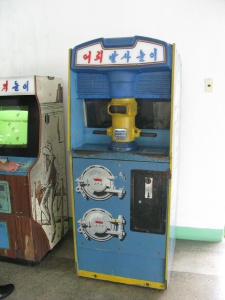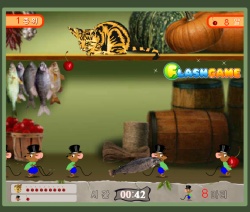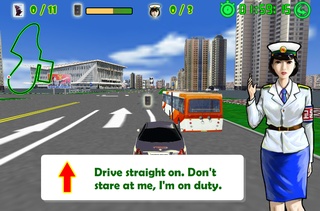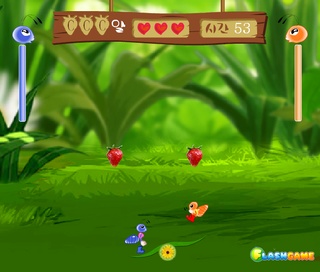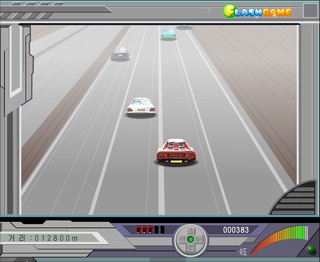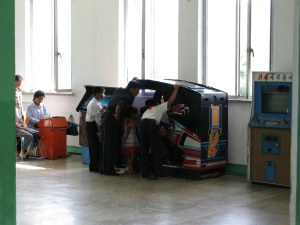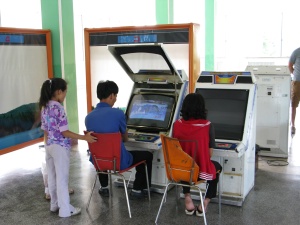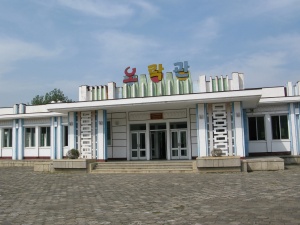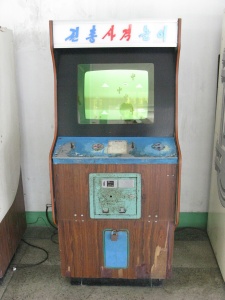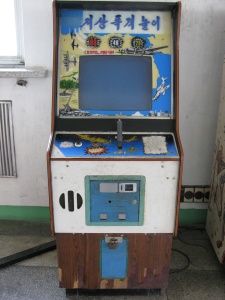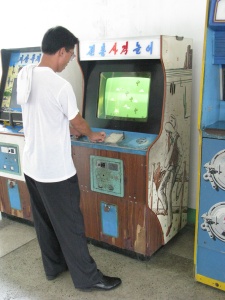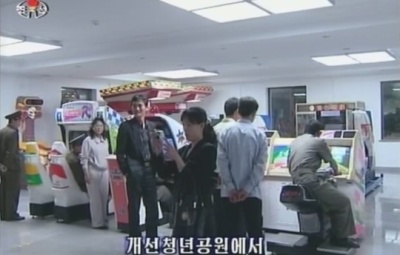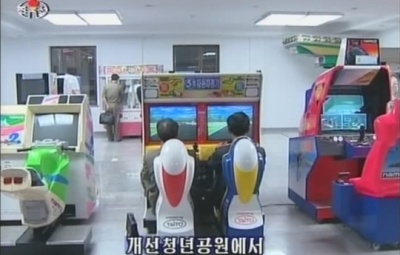A History of Korean Gaming
The Other Korea: Gaming in the North
Very little is known in the west about the actual life of normal people in North Korea, and the same applies all the more to topics of minor interest to the "general public," like video gaming culture. Eric Lafforgue took some pictures of children playing Famicom games like Double Dragon on a Famiclone from the (in)famous Micro Genius series in Songdowon international children's camp in Wonsan, during one of his trips to North Korea. Similar equipment has been shown to exist at Magyeongdae in Ingeun, Pyongyang1.
The earliest report about arcade games in North Korea reached the South in the earlier 1990s, when a goldfish store opened in Pyongyang's Reunification Street, which also happened to hold arcade machines for the kids2. Mention of a dedicated arcade followed in 19993, though information on further details was once again very sparse, as would be expected. More recently (September 2008), a series of pictures supposedly taken at a North Korean arcade by an anonymous photographer surfaced on the net, showing a few archaic machines in changed cabinets with labels in Korean (they have been identified with Midway's Gun Fight from 1975, Electra's Flying Fortress from 1977 and Midway's Submarine from 1979) next to various well known 80's games in standard Sega Aero City cabinets, like Konami's Yie Ar Kung Fu4.
These photos have been abused as a laughingstock around the internet like so many other "news" from the country. However, it should be taken into account that very little is known about the context of the pictures. The arcade might have held on to the ancient machines intentionally. For all we know, the photos could as well have been taken in a Korean community in Russia and China, or even in some rural village in South Korea, given their anonymous status. Not to forget that the most widespread video game technology tends to develop in accordance with a country's average income, as proven by the Sega Master System's ongoing success in much of South America.
On the flipside of the coin, everything seen in pictures taken in North Korea may exist just because the government there wants it to be seen from the outside, and there's nothing that can be said about the average North Korean's access to video games outside of those special places, which are often aimed at tourists and/or upper class citizens. At least by 2010, North Korea was able to present an arcade with more modern equipment (mostly machines from the 1990s) at Gaeseon Amusement Park near Pyongyang5. In 2012, Hardcore Gaming 101 reader Mike Koz visited Pyongyang and discovered two arcade areas inside a bowling alley and the Taedonggang Diplomatic Club. We're hosting a photo stretch in our Games of the World section.
North Korea doesn't have a dedicated games industry to speak of, but there are a few documented cases of video games developed at least partially in North Korea or by North Koreans. In 1998, DreamTech published the baduk (go)-software Medusa, which was co-developed by the Russian Alexei Telitsine and Pak Cheoljin, who had defected from North Korea in 1992 and studied at the University of St. Petersburg and Chungang University in South Korea6.
Roughly three years later, PC Power Zine eagerly reported in it's November 2001 issue: "North and South develop games together."7 The actual story: The unification activist company Minjog21 had founded an IT-subsidiary called Hana Soft in Dandong, in China's Liaoning province, which employed some forty North Korean staff members. However, neither Minjog21 nor Hana Soft's homepage mentioned the development of any computer games.
At least one North Korean video game is very well known at least throughout East Asia. Eunbyeol Baduk, as the title reveals, is yet another baduk program, developed at the Korean Computer Center since 1997 and first published in several capitalist countries in 1999 by Silver Star. The program was considered the best Go software in Japan in 20068, known there as Ginsei Igo. There's even a DS version by EA, but it is unlikely that that one was also made in North Korea.
In September 2006, the flash game portal flashgame.co.kr announced a cooperation with Joseon Ryugiro Pyeonjipsa, which resulted in 22 "North Korean" flash games, but it remains uncertain how the workload was shared in between the two companies.
Finally, there was Nosotek, a German-North Korean joint venture established in 2007. The company provided outsourcing services for mobile flash and Facebook games, which have been distributed in Germany through Exozet, including the puzzle game Bobby's Blocks9. Nosotek's most (in-)famous product is the racing game Pyongyang Racer, created 2012 in cooperation with students from Kim Chaek University of Technology as a commission for the the Beijing-based British travel company Koryo Tours and playable on the Koryo Tours website. Novotek's website has been closed in early 2013.
Pyongyang Racer
Other North Korean Flash Games
Alleged North Korean Arcade, via UK Resitance
Photos from the Gaeseon arcade in 2010:
References
1. Two fotos by Eric Lafforgue and Minjog21 9/1/2001
2. Kyunghyang Shinmun December 28th, 1992, page 21
3. Amuse World 9/1999, page 131
4. UK Resitance: Inside a North Korean Arcade
5. Naver News 6/3/2010
6. Dong-a.com 3/19/1998
7. PC Power Zine 11/2001, page 163
8. Sangkeum-han Bangnanggi Blog 10/20/2008 (archived 6/18/2010)
9. Computerworld - The world's most unusual outsourcing destination

